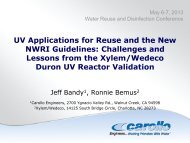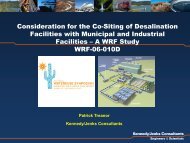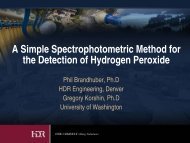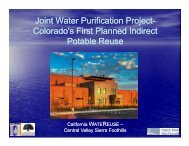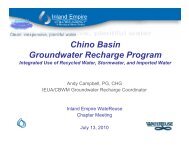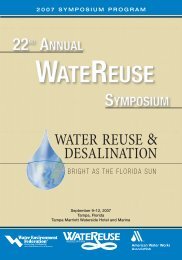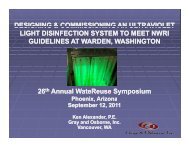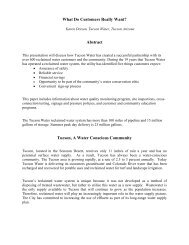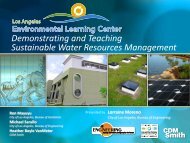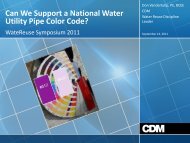treatment of oilfield produced water for industrial reuse - WateReuse ...
treatment of oilfield produced water for industrial reuse - WateReuse ...
treatment of oilfield produced water for industrial reuse - WateReuse ...
You also want an ePaper? Increase the reach of your titles
YUMPU automatically turns print PDFs into web optimized ePapers that Google loves.
TREATMENT OF OILFIELD PRODUCEDWATER FOR INDUSTRIAL REUSEUpdated September 09 |
Regulatory Framework• Trinidad & Tobago (T&T) EnvironmentalManagement Agency (EMA) enacted WaterPollution Amendment Rules in 2006• Water Pollution Rules require pollution“Source Registration” with limits <strong>for</strong>“parameters or substances…likely to causeharm to human health and the environment”
Regulatory Framework• Purpose is to “maintain an intelligentinventory or record <strong>of</strong> all <strong>water</strong> pollutantsources in the country”• EMA can monitor progress on pollution reductionplans• Well-in<strong>for</strong>med communities can protectthemselves from risk• Industry can improve process, safety, and publicimage
Current Site ConditionsProducing WellsStorage Tanks andWash Tank
Current Treatment SystemWater from wash tank tooil/<strong>water</strong> separationOil/<strong>water</strong> separation inlet
Current Treatment SystemOil/<strong>water</strong> separation outletSurface <strong>water</strong> outfall
Project Background• Original plan – four <strong>produced</strong> <strong>water</strong><strong>treatment</strong> plants (WTPs)• "Sticker shock" changed scope to one largerWTP receiving <strong>produced</strong> <strong>water</strong> from 3 fields• Design is a subcontract to constructor, T.N.Ramnauth & Co., Ltd. (TNR)• TNR will build, own and operate the WTP <strong>for</strong>ten years under contract to oil company
Influent Design Basis and Treatment GoalsParameter Units InfluentvalueIndustrial<strong>reuse</strong>standardNearshoredischargelimitFlow rate bpd 25,000 ≥ 12,500 ≤ 12,500Oil & grease mg/L 1,900 < 1.4 NAChloride mg/L 4,500 < 55 NIAA*Chemicaloxygen demandmg/L 4,000 250 250NIAA = no increase above ambient
Treatment Goals• Consideration <strong>of</strong> standards <strong>for</strong> <strong>reuse</strong>, inlandor nearshore discharge, or drinking <strong>water</strong>• Treated <strong>water</strong> splits 50/50, <strong>for</strong> <strong>industrial</strong><strong>reuse</strong> and nearshore ocean discharge• Reuse quality standards must be met <strong>for</strong>“clean” stream, nearshore dischargestandards must be met <strong>for</strong> waste stream
Treatment Process Overview• Unit Operations• Oil/<strong>water</strong> separation• Equalization basin (1-day, ~1 million gallons)• Dissolved air floatation• Cooling• Aerobic bio<strong>treatment</strong>• Settling (1-day, ~1 million gallons)• Media filtration and reverse osmosis• RO permeate to <strong>industrial</strong> <strong>reuse</strong> (boiler feed)• RO concentrate to permitted nearshore ocean outfall
Treatment Overview - Secondary Streams• Oil/<strong>water</strong> separator – oil to storage tank,settled solids to waste basin• DAF float and settled solids to waste basin• Settling basin solids, mucked out as neededand “landfarmed” prior to <strong>of</strong>fsite disposal• RO prefilter waste stream to waste basin• Waste basin – can be returned to process,mucked out as needed
Treatment Plant Site Plan
Pipeline Route <strong>for</strong> Nearshore Discharge• Typical vegetation encountered on 10 kmroute
Pipeline route <strong>for</strong> nearshore discharge• Drop<strong>of</strong>f to the beach• Pipeline and outfall design to be done locally
Bench Testing• Blended influent analytical baseline –samples from 3 tank farms, analyzed <strong>for</strong> fullsuite or organics, metals, common ions• Bulk samples collected <strong>for</strong> DAF coagulantand polymer dose determination through jartesting (7 batches over a period <strong>of</strong> months)• DAF-treated <strong>water</strong> then used <strong>for</strong>bio<strong>treatment</strong> bench tests
DAF Bench Testing ResultsParameter Units Be<strong>for</strong>e DAF<strong>treatment</strong>After DAF<strong>treatment</strong>Total suspended mg/L 41 - 593 33 – 104solids (
DAF Bench Testing Results• 7 batches processed with:• a range <strong>of</strong> coagulant and polymer doses;•varied polymer products (anionic/cationic)• Relatively consistent DAF effluent despitewider variation in influent <strong>water</strong> quality• Upstream equalization should help level“peaks and valleys”• DAF polymer options may be needed
Bench Testing <strong>for</strong> Biological Treatment• Immobilized Cell Bioreactor (ICB)• Smaller footprint than lagoons or CSTRs• Minimal production <strong>of</strong> secondary waste(biosolids stay in reactor)• Diverse, dense, long-lived microbialpopulation• Mechanical simplicity – aeration blowers andgravity flow in series reactor configuration
Bench Testing <strong>for</strong> Biological TreatmentBench scale ICBsMicrobial growth onmedium
Biological Treatment Bench Results• Individual source <strong>water</strong>s tested in enrichmentcolumns – aerated, fed N and P, pH adjusted• COD removal efficiency <strong>for</strong> one source was90%, considerably lower <strong>for</strong> the other two• Difference is attributed to secondaryrecovery techniques• Based on influent blend, a 50% CODremoval efficiency is predicted
Biological Treatment Bench Results• Flow-through bioreactors used primarily tooptimize hydraulic retention time (HRT)• Using DAF treated <strong>water</strong> as bio<strong>treatment</strong>feed, HRT was optimized at 18 hours• COD “endpoint” <strong>of</strong> ~250 mg/L was reachedregardless <strong>of</strong> COD influent concentration
Bio<strong>treatment</strong> Bench Testing ResultsAnalysis <strong>for</strong> BOD and COD reveals recalcitrant CODParameter Units Bio<strong>treatment</strong>influentBiological oxygendemand (BOD)Chemical oxygendemand (COD)Bio<strong>treatment</strong>effluentmg/L 260 Non-detectablemg/L 640 240Crux <strong>of</strong> the challenge – 250 mg/L COD limit <strong>for</strong> both ROpermeate (<strong>reuse</strong> <strong>water</strong>) and RO concentrate (nearshoredischarge)
Supplemental Treatment <strong>for</strong> COD Reduction• Ideally, a COD concentration <strong>of</strong> ~100 mg/L isneeded prior to RO.• Supplemental <strong>treatment</strong>s evaluated•Anaerobic/aerobic bio<strong>treatment</strong>•Adsorption on granular activated carbon•Electrocoagulation•Chemical oxidation•Filtration
Supplemental Treatment <strong>for</strong> COD Reduction• Marginal results <strong>for</strong> supplemental processes•Anaerobic/aerobic – same COD endpointas aerobic <strong>treatment</strong> alone•Carbon adsorption – high operating cost•Electrocoagulation – ineffective on COD•Chemical oxidation – costly, hazardous•Filtration – 0.02, 0.01 and 0.005 µmineffective
Now what??• Literature research•Treatment process(es) selected <strong>for</strong><strong>produced</strong> <strong>water</strong>•COD endpoint, characterization andtoxicity•COD analytical technique in presence <strong>of</strong>chloride interference
Literature Research• Process selection• Bench testing <strong>for</strong> desalination <strong>of</strong> <strong>produced</strong> <strong>water</strong>identified an optimum process train includingoil/<strong>water</strong> separation, DAF, micr<strong>of</strong>iltration, carbonadsorption, and RO• Bio<strong>treatment</strong> bench tests reached endpointconcentration <strong>for</strong> COD due to “recalcitrant organiccompounds” but is considered “cheap, effective andenvironmentally friendly” <strong>for</strong> COD reduction
Literature Research• COD in treated effluent• Multiple studies showed COD concentrations in therange <strong>of</strong> 200 to 300 mg/L• Extensive analytical program to identifycomponents <strong>of</strong> recalcitrant COD resulted inapproximately half “unknown”• One study reported 230 mg/L COD in treatedeffluent as “non-toxic to Artemia salina, which arevery frail organisms used to assess ecotoxicity”
Literature Research• Presence <strong>of</strong> chloride affects COD analysis –resulting in false high COD concentration• Various analytical methods are adapted tocorrect <strong>for</strong> this interference• New “modified method” shows bettercorrection than others, resulting in 90+percent accuracy• Independent method comparison is ongoing
Literature Research Impact• Unit operations selected are “state <strong>of</strong> the art”• Influent COD volatiles, insolubles, and solids –physical separation processes treat a highpercentage <strong>of</strong> influent COD• Soluble COD can be reduced to a concentration <strong>of</strong>about 200 mg/L through bio<strong>treatment</strong>• Modified analytical method could show actual CODconcentration is lower than previously reported
Conclusions• All insoluble COD and half <strong>of</strong> soluble COD will beeffectively removed, a 90 percent COD massreduction, influent to effluent• Modified analytical method may show that actualCOD after bio<strong>treatment</strong> is about 100 mg/L, andnearshore discharge COD limit <strong>for</strong> RO concentratewill be met• If a treated stream <strong>for</strong> <strong>industrial</strong> <strong>reuse</strong> was notneeded, all nearshore discharge limits would bemet as biotreated effluent
Thank you!Questions?Golder Associates Inc. - Peter Lemke, Kevin ConroyTN Ramnauth & Co. Ltd. – Isaac Jurawan




